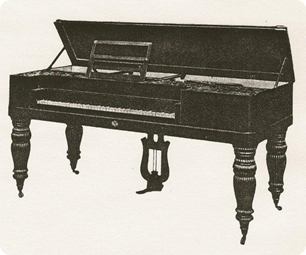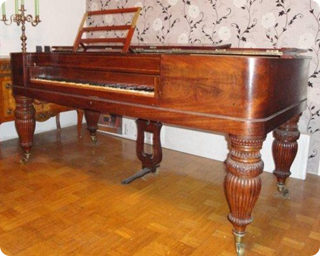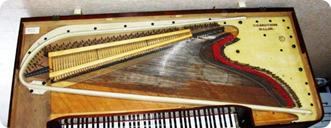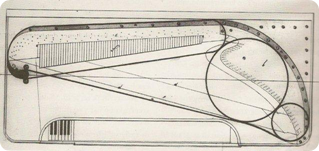Square piano, O. B. Malmö, c. 1840, (KH 500)
In Klaverens Hus’ collections there is an instrument, which is outwardly identical to square piano nr. 1 by Johan Gustaf Malmsjö, but molded into the frame and on a printed label in its upper left corner bears the name O.B. Ekström Malmö (KH 500).
Olof Berndt Ekström (1807-1857) appears to be an interesting piano maker with a particular eye for new constructions. For example, in the Swedish context, he is very early in building cross-strung square. He showed such instrument at the Slöjd-Exposition in Malmö in 1849, whose catalog includes “a square piano with crossed strings” (catalog no. 533), and at the Exposition in 1857 in the same city, when he exhibited a “Fortepiano, table-shaped, with superimposed bases” ( catalog no. 678). Two such are known so far, one from about 1845-1850 in Klaverens Hus (KH 127), the other from about 1855 in Malmö museums (MMI 2598).


Johan Gustaf Malmsjö (1815-1891) established himself in Gothenburg at the beginning of 1844. Before then he had learned the piano maker’s trade with Olof Ekström in Malmö 1836-1838, and worked with Andreas Marschall in Copenhagen 1838-1842. After that, Malmsjö returned for a time to Ekström in Malmö, where he made his “two first pianos completely by himself, from the smallest detail to the finished instrument” (Förenades Pianoblad, Centenary Yearbook, p. 3). He brought them with him to Gothenburg as a starting capital, when on 1 December 1843 he signed his application for privileges in this city. What Malmsjö did in the autumn of 1843, was construct two square pianos with reference to his master’s design.
Olof Ekström’s square piano is from the outside a well-crafted instrument in mahogany, where the carver has shown his art in terms of the design of the legs and the heavy, decorative carved grille that protects some of the mechanics and stringing. Even if the design of the frame is above the ordinary, this square’s value lies in its unusual construction in Sweden. Under the lid is an iron frame with a crossbar, which starts from the rear part of the hitchpin plate and runs along the back edge, turns around along the left side edge and then extends along the base strings to end in the front part of the hitchpin plate. The frame with the factory name cast into it and the long, forked slats are fully cast. Without a doubt, we have here the oldest known example of a fully cast frame in a Swedish hammer-instrument, which is even early internationally.


The model does not appear to have been directly adopted from any of the frame constructions that have received attention so far in our general piano history, where cast iron was used early on. Although attempts with metal frames were made during the first quarter of the 19th century, the American piano maker Alphaeus Babcock is usually considered to be the first with his two frame patents for tables from 1825 and 1830 (where the latter primarily concerned cross-stringing). There are tangible similarities between Babcock’s design and the solution Ekström would put into practice.
The practice of using fully cast frames quickly spread throughout the piano world. In the Nordic countries, the Dane Conrad Christian Hornung received a patent in 1842 for his cast iron frame. Shortly before that, Andreas Marschall had created his variant with a frame like a triangle, however with reinforcing circles and an oval around the wrestplank, but without metal over it. There is not much, basically just the circles, that separates this solution from Babcock’s frame seventeen years earlier. It is therefore easy to interpret Ekström’s fully cast frame as a variant of Babcock’s and Marschall’s frames.